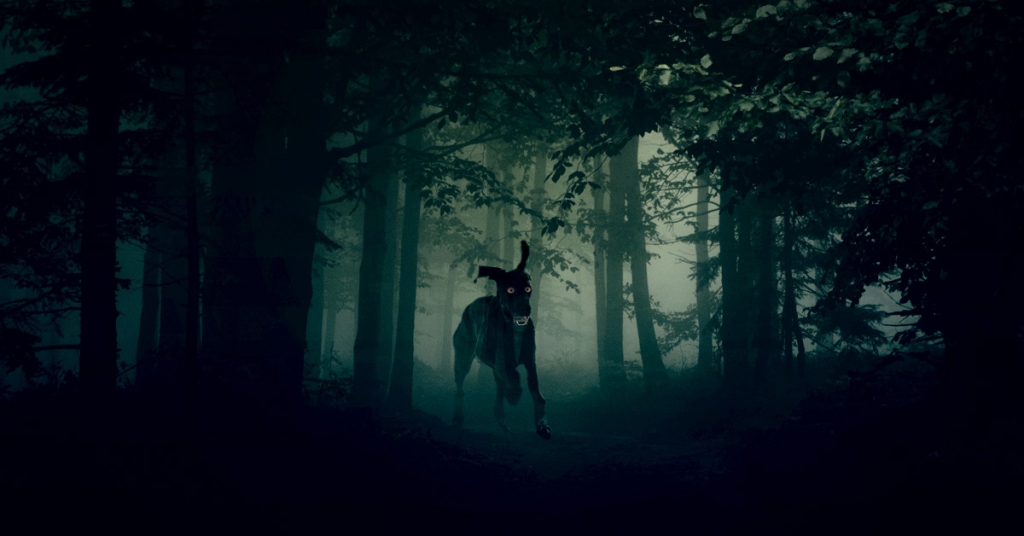THE YORK BARGUEST AND THE SWANCLIFFE BLACK DOG

There is a ghostly black hound that haunts the snickets and back streets of York known as a Barguest, the name thought to derive from the north of England pronunciation of ‘ghost’ as ‘guest’ and combined with burh, a fortified settlement; thus we have burh-ghest or ‘town-ghost’. A particularly fearsome creature, encounters were relatively frequent according to British folklore and were rarely considered a positive experience.
That, however, cannot be said for the case of Johnnie Greenwood, whose tale was recorded by the marvellously monikered Augustus Hare in his The Story of my Life, published in 1896.
Hare wrote that Johnnie Greenwood resided in Swancliffe, England and a particular journey on one occasion necessitated a ride through a wood. As Greenwood entered the wood and began galloping along the mile long stretch of road that would lead him to his destination he was alarmed to witness a large, black dog emerging from the trees and join him, keeping apace with his horse and staying with him until the wood came to an end . As he emerged from the wood he realised that the dog had disappeared, although there were no visible signs as to where it could have gone. Later in the day, his business concluded, Greenwood returned along the same road and upon entering the wood was once again joined by the large, black dog. As before, his emerging from the wood resulted in the disappearance of the animal and he completed his journey back to Swancliffe with no further incident.
Curious enough in itself, a confession by two prisoners in York jail some years later added a compulsive and corroborating element. The very day that Greenwood had his most singular encounter, the two men had been lying in wait with the intention of murdering and robbing the unwitting Greenwood on his journey through the dark wood, but on both occasions they witnessed a large, black dog running alongside his horse and decided that an assault on Greenwood when in the company of such a creature was more than their courage would allow and consequently abandoned their plan.
Johnnie Greenwood recounted his original tale to a friend by the name of Mr. Wharton, who in turn passed the story on to Hare as they dined together in Ayscliffe. Which does, admittedly, make this a Victorian FOAF [1] tale and therefore a candidate for urban myth status, but it must be said that Mr. Greenwood was a personal friend of Mr. Wharton’s and not just a nondescript acquaintance.
In addition, as pointed out by Garth Haslam [2] on his excellent website anomalyinfo.com, there is no such place in England as Swancliffe, nor is there any such place as Ayscliffe. However, there is a Swalcliffe in County Durham, just north of York, and nearby is a town by the name of Newton Aycliffe, which originally was know just as Aycliffe. As such, the slight discrepancies in the names aside, it would appear that these are the locations detailed in the account by Hare. Which inevitably leads one to speculate as to whether the large, black dog was in any way connected to the creature so often reported in York. It would be but a short run (for a demonic hound) up the A64 (although that wasn’t built until 1969 so it would have been the old Roman road back in Greenwood’s day) and it may well be that ghostly black dogs have large territories.
What’s more difficult to speculate upon is the reason for the hounds apparently altruistic behaviour. When a large, black creature with glowing red eyes the size of saucers mysteriously appears out of nowhere it is traditional for it to be a sign of impending peril, which is undoubtedly the situation that Greenwood unknowingly faced. However, like the Irish Banshee they appear, frighten the life out of everyone and then disappear, leaving witnesses wondering what form the impending terror may take. What they do not usually do is intervene in a manner that removes the threat. This, in a sense, makes their appearance in the first place somewhat contradictory. How did it appear as a result of impending peril when its action when it did appear removed that peril?
A paranormal paradox?
- FOAF. Friend Of A Friend. As with the term ‘urban myth’, or ‘urban legend’, it is a way of saying that the story is a load of old hogwash.
- Garth’s website is where I came across this story so I am indebted to him for documenting it, along with a link to the source material: The Story of My Life, Vol. IV, by Augustus J.C. Hare, 1900 London, England: http://www.gutenberg.org/ebooks/42770.
